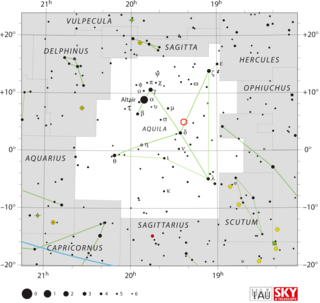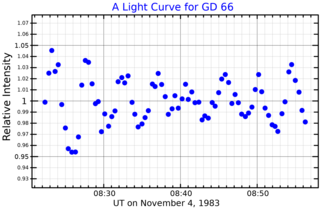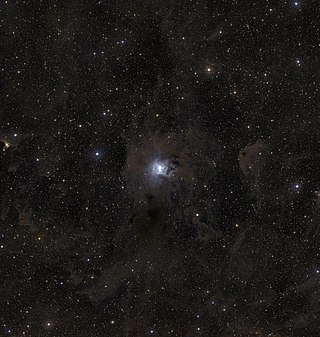
Mira variables are a class of pulsating stars characterized by very red colours, pulsation periods longer than 100 days, and amplitudes greater than one magnitude in infrared and 2.5 magnitude at visual wavelengths. They are red giants in the very late stages of stellar evolution, on the asymptotic giant branch (AGB), that will expel their outer envelopes as planetary nebulae and become white dwarfs within a few million years.

Asteroseismology is the study of oscillations in stars. Stars have many resonant modes and frequencies, and the path of sound waves passing through a star depends on the speed of sound, which in turn depends on local temperature and chemical composition. Because the resulting oscillation modes are sensitive to different parts of the star, they inform astronomers about the internal structure of the star, which is otherwise not directly possible from overall properties like brightness and surface temperature.

BPM 37093 is a variable white dwarf star of the DAV, or ZZ Ceti, type, with a hydrogen atmosphere and an unusually high mass of approximately 1.1 times the Sun's. It is 48 light-years from Earth in the constellation Centaurus and vibrates; these pulsations cause its luminosity to vary. Like other white dwarfs, BPM 37093 is thought to be composed primarily of carbon and oxygen, which are created by thermonuclear fusion of helium nuclei in the triple-alpha process.

V1494 Aquilae or Nova Aquilae 1999 b was a nova which occurred during 1999 in the constellation Aquila and reached a brightness of magnitude 3.9 on 2 December 1999. making it easily visible to the naked eye. The nova was discovered with 14×100 binoculars by Alfredo Pereira of Cabo da Roca, Portugal at 18:50 UT on 1 December 1999, when it had a visual magnitude of 6.0.

RV Tauri variables are luminous variable stars that have distinctive light variations with alternating deep and shallow minima.

Upsilon Orionis is a star in the constellation Orion. It has the traditional name Thabit or Tabit, a name shared with pi3 Orionis. It is a blue-white main sequence star of apparent magnitude 4.62 located over 3000 light-years distant from the Solar System. It is a suspected Beta Cephei variable.

Giclas 29-38, also known as ZZ Piscium, is a variable white dwarf star of the DAV type, whose variability is due to large-amplitude, non-radial pulsations known as gravity waves. It was first reported to be variable by Shulov and Kopatskaya in 1974. DAV stars are like normal white dwarfs but have luminosity variations with amplitudes as high as 30%, arising from a superposition of vibrational modes with periods from 100 to 1,000 seconds. Large-amplitude DAVs generally differ from lower-amplitude DAVs by having lower temperatures, longer primary periodicities, and many peaks in their vibrational spectra with frequencies which are sums of other vibrational modes.

HL Tau 76 is a variable white dwarf star of the DAV type. It was observed by G. Haro and W. J. Luyten in 1961, and was the first variable white dwarf discovered when, in 1968, Arlo U. Landolt found that it varied in brightness with a period of approximately 749.5 seconds, or 12.5 minutes. Like other DAV white dwarfs, its variability arises from non-radial gravity wave pulsations within itself., § 7. Later observation and analysis has found HL Tau 76 to pulsate in over 40 independent vibrational modes, with periods between 380 seconds and 1390 seconds.
A pulsating white dwarf is a white dwarf star whose luminosity varies due to non-radial gravity wave pulsations within itself. Known types of pulsating white dwarfs include DAV, or ZZ Ceti, stars, with hydrogen-dominated atmospheres and the spectral type DA; DBV, or V777 Her, stars, with helium-dominated atmospheres and the spectral type DB; and GW Vir stars, with atmospheres dominated by helium, carbon, and oxygen, and the spectral type PG 1159. GW Vir stars may be subdivided into DOV and PNNV stars; they are not, strictly speaking, white dwarfs but pre-white dwarfs which have not yet reached the white dwarf region on the Hertzsprung-Russell diagram. A subtype of DQV stars, with carbon-dominated atmospheres, has also been proposed, and in May 2012, the first extremely low mass variable (ELMV) white dwarf was reported.

Ross 548 is a white dwarf in the equatorial constellation of Cetus. With a mean apparent visual magnitude of 14.2 it is much too faint to be visible to the naked eye. Based on parallax measurements, it is located at a distance of 107 light years from the Sun. It was found to be variable in 1970 and in 1972 it was given the variable star designation ZZ Ceti. This is a pulsating white dwarf of the DAV type that is the prototype of the ZZ Ceti variable class., pp. 891, 895.

PG 1159-035 is the prototypical PG 1159 star after which the class of PG 1159 stars was named. It was discovered in the Palomar-Green survey of ultraviolet-excess stellar objects and, like the other PG 1159 stars, is in transition between being the central star of a planetary nebula and being a white dwarf.

GD 358 is a variable white dwarf star of the DBV type. Like other pulsating white dwarfs, its variability arises from non-radial gravity wave pulsations within the star itself. GD 358 was discovered during the 1958–1970 Lowell Observatory survey for high proper motion stars in the Northern Hemisphere. Although it did not have high proper motion, it was noticed that it was a very blue star, and hence might be a white dwarf. Greenstein confirmed this in 1969.

GD 66 or V361 Aurigae is a 0.64 solar mass (M☉) pulsating white dwarf star located 170 light years from Earth in the Auriga constellation. The estimated cooling age of the white dwarf is 500 million years. Models of the relationship between the initial mass of a star and its final mass as a white dwarf star suggest that when the star was on the main sequence it had a mass of approximately 2.5 M☉, which implies its lifetime was around 830 million years. The total age of the star is thus estimated to be in the range 1.2 to 1.7 billion years.

T Cephei is a Mira variable star in the constellation Cepheus. Located approximately 600 light-years distant, it varies between magnitudes 5.2 and 11.3 over a period of around 388 days.

Classical Cepheids are a type of Cepheid variable star. They are young, population I variable stars that exhibit regular radial pulsations with periods of a few days to a few weeks and visual amplitudes ranging from a few tenths of a magnitude up to about 2 magnitudes. Classical Cepheids are also known as Population I Cepheids, Type I Cepheids, and Delta Cepheid variables.

TY Coronae Borealis, also known as Ross 808, is a variable white dwarf star of the DAV type in the constellation Corona Borealis. It has a surface temperature of 11,213 ± 130 K and a mass around 70% times that of the Sun, but only 1.1% of its diameter. It is 107 light-years distant from Earth. It was confirmed as a variable star in 1976.
Kepler de Souza Oliveira Filho, also known as S. O. Kepler, is a Brazilian astronomer primarily known for his work on white dwarfs, variable stars, and magnetars. A member of the Brazilian Academy of Sciences, he is currently a professor at Universidade Federal do Rio Grande do Sul (UFRGS).
MY Apodis, also known as L 19-2, GJ 2108, or WD 1425-811, is a single white dwarf star located in the far southern constellation Apus. It is a low-amplitude variable star with an average apparent visual magnitude of 13.75 and thus is much too faint to be visible to the naked eye. Based on parallax measurements, this star is located at a distance of 68.3 light-years from the Sun. It is drifting further away with a radial velocity of 58.0

AR Scorpii is a binary pulsar that consists of a white dwarf and a red dwarf. It is located close to the ecliptic plane in the constellation Scorpius. Parallax measurements made by Gaia put the system at a distance of about 380 light-years.
Kepler-429 is a variable subdwarf B star in the constellation Lyra, about 5,900 light years away.
















